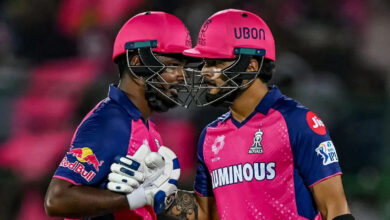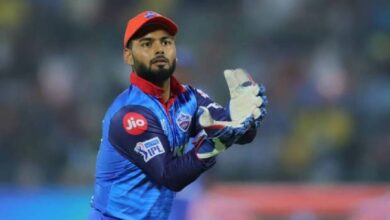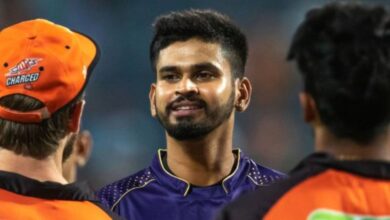How dhanushya-baan, fancy dress contests at Jatras kickstarted archery trend in Maharashtra | Asian-games News

The photo speaks the proverbial thousand words.It’s of a young girl, no more than six or seven years old. Dressed ostensibly like Rani Lakshmi Bai. Holding up a bow with her left hand and pulling an arrow with her right. Eyes locked on the target. Body, though awkwardly positioned, still as a rock. Ready to shoot.It isn’t a competition shot.
The young girl in the warrior queen avatar was among the hundreds taking part in the annual jatra – festival – that passed through her village near Amravati, Maharashtra. For close to a decade and a half, dhanushya-baan has become a regular feature at these village carnivals.
A young girl dressed as a warrior queen was among the hundreds taking part in the annual jatra that passed through her village near Amravati.
But what started as fancy-dress events have now turned into a grassroots sports revolution. “Today, there are thousands of archers across various dricts of Maharashtra,” says Gopichand Swami.
A mathematics teacher from Shirgaon in Satara, Gopichand assures the number is not exaggerated. He has seen up-close children, as tall as a bow-and-arrow held upright, walk into the academies dotted across the state, hundreds of pre-teens lining up at local tournaments and the rising participation numbers at drict-level meets.
It’s after passing through this grind that Gopichand’s daughter Aditi has emerged as the world’s latest sensation – only 17, she is already the youth and senior world champion in compound archery.
The girl with the golden arrow is one of India’s biggest medal hopes at the Hangzhou Asian Games. And she, Gopichand says, is the product of a robust system that has been more than 15 years in the making.
Aditi isn’t the only one. Parth Salunkhe, Prathamesh Jawkar, Ojas Deotale and Tushar Shelke are all medal contenders in a sport that’s synonymous with South Korea.
The majority of them have emerged as world-beaters in the compound category, which is right now a non-Olympic event. However, with the category set to make its debut at the LA Games in 2028, the rise of compound archers bodes well for India.
Grassroots programme
And behind their emergence is a unique grassroots programme, launched former India archer and coach Pramod Chandurkar. “In around 2004-05, I was reading stories about China’s success at the Olympics; how a child started training in swimming or gymnastics from a very young age,” Chandurkar, now the secretary of the Archery Association of India, says. “So I thought, why can’t we do it in archery?”
It’s not the first time someone has asked the ‘if-China-can-why-can’t-we’ question in India. But Chandurkar did not try to copy from their highly secretive playbook. He simply looked around himself for inspiration. “I observed that in every village there was a strong tradition of organising jatras. At these jatras, often the first choice for kids who were aged 5 or 6 used to be dhanushya-baan. Of course, they never saw it as a sport. For them, it was just a recreational activity. But in that, I saw an opportunity,” Chandurkar, who was the secretary of the Maharashtra Archery Association at the time, says.
In Maharashtra, what started as fancy-dress events have now turned into a grassroots sports revolution for the sport of archery.
Until then – the mid-2000s – the earliest age group for archers in India was under-14. That, like in many other sports, was a handicap because in other countries, especially powerhouses like South Korea and China, training began at the age of 5 or 6, which meant that an Indian athlete, who usually started at 11 or 12 years, was playing catch-up even before stepping on the competitive field.
To fix this anomaly, the Maharashtra Archery Association (MAA) collaborated with the festival organisers at a drict level in the hope that the bow-and-arrow events would become a scouting ground for potential archers.
Chandurkar himself spoke to parents and encouraged them to send their children to these events. But in his conversations, he never sold them Olympic dreams. “If I told the parents that I’ll make your child an Olympian, they would think it’s some kind of a scam,” Chandurkar laughs.
So, it was packaged as a fancy-dress competition. Parents were urged to send their children to the ground dressed up as warrior princesses and princes, raja-maharajas and mythological figures. The concept did not need a lot of convincing. Just like that, from the malls in Baramati to the temple town of Shirdi, the parched lands in Beed to the plateaus of Satara, children dressed in the costumes of Lord Ram to Bahubali and everyone in between started to pour in at the archery festivals, where coaches kept a keen eye on anyone who would show some promise.
There wasn’t any dearth of coaches either, given that the MAA had spent nearly five years before launching the talent hunt programme on developing coaches and judges across the state.
Shooting for fun
The coaches weren’t looking for bulls-eye or inner-10s. Neither were these competitions where every shot was scored and medals would be handed out at the end. There were no losers or winners either. Just a harmless fun activity where kids were given a bow and an arrow, and asked to have a go.
“We didn’t even want to see if the child would hit the target, he or she was too young to understand the nuances of the sport. But it encouraged parents to bring their children to the ground. And instead of the pressure of winning or fear of losing, we wanted to see if the children would enjoy archery,” Chandurkar says. “The purpose of that project wasn’t to see how many medals they won. The idea was to generate interest in the child at a young age.”
Praveen Sawant, the coach responsible for producing world champions Aditi Swami and Parth Salunkhe, adds: “These under-9 events were a game-changer. Parents were thrilled to see their children dressed up as raja-maharajas and the children were excited to shoot an arrow. Nagar, Shirdi, Nanded, Buldhana…everywhere we got a very good response.”
From a handful of unregered archers until the end of last century, Maharashtra now has approximately 6,000 regered archers across different age groups in recurve, compound and Indian (where bamboo-made bows and arrows are used) styles, Chandurkar claims.
He is careful not to attribute the entire success to the fancy dress events at the village festivals. “But they helped us create an environment for mass participation,” Chandurkar says. “It helped us to popularise the sport at a village and drict level.”
Archery’s popularity in her village was the reason Aditi got lured to the sport. “And we had seen that there was a system in place,” Gopichand, her father, says.
It wasn’t smooth sailing all the time. As in most other sports, the state association was financially crippled and with few willing to sponsor grassroots-level events, it became tougher with every passing year to sustain.Most Read
1
Jawan box office collection day 8: Shah Rukh Khan-starrer steamrolls over Gadar 2’s chances of beating Pathaan, eyes Rs 700 crore worldwide
2
Pakan vs Sri Lanka, Asia Cup 2023 Highlights: SL beat PAK two wickets in thriller, will face India in summit clash
See More
But it helped that Chandurkar had his own archery equipment manufacturing business, which he started soon after leaving the position of a coach with the Sports Authority of India in 2000. “I don’t know how, but we managed it somehow. For one championship, we need 50 targets. We didn’t have the money to buy that but because I was into that business, we’d borrow the targets for a tournament,” Chandurkar says.
Today, the system works on a virtual auto-pilot. Coaches like Sawant are peppered across the state, finding young talent and honing them. The success of the ‘pilot project’ has resulted in it being implemented on a similar scale in other regions, armed a PSU sponsor which has eased the financial burden on the federation. Like Maharashtra, Andhra Pradesh, too, is turning out to be another hub.
“States like Maharashtra are feeder agencies, and when the feeder agency provides maximum archers to the national team, then you get a couple of toppers,” Chandurkar says. “To become a World or Olympic champion, you need rigorous training from a young age. No one can stop you from becoming a champion then.”
Seventeen-year-old Aditi Swami is an embodiment of that philosophy.







